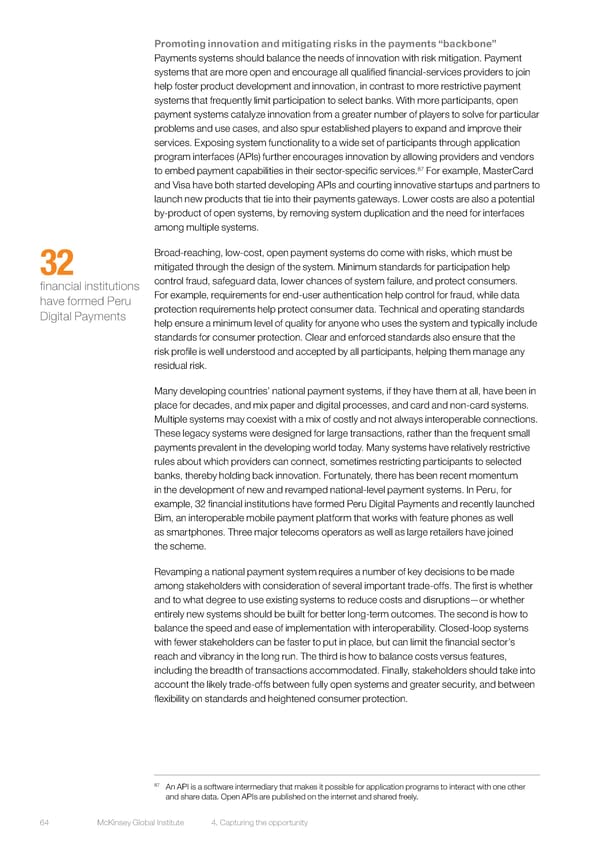Promoting innovation and mitigating risks in the payments “backbone” Payments systems should balance the needs of innovation with risk mitigation. Payment systems that are more open and encourage all qualified financial-services providers to join help foster product development and innovation, in contrast to more restrictive payment systems that frequently limit participation to select banks. With more participants, open payment systems catalyze innovation from a greater number of players to solve for particular problems and use cases, and also spur established players to expand and improve their services. Exposing system functionality to a wide set of participants through application program interfaces (APIs) further encourages innovation by allowing providers and vendors 87 For example, MasterCard to embed payment capabilities in their sector-specific services. and Visa have both started developing APIs and courting innovative startups and partners to launch new products that tie into their payments gateways. Lower costs are also a potential by-product of open systems, by removing system duplication and the need for interfaces among multiple systems. Broad-reaching, low-cost, open payment systems do come with risks, which must be 32 mitigated through the design of the system. Minimum standards for participation help financial institutions control fraud, safeguard data, lower chances of system failure, and protect consumers. have formed Peru For example, requirements for end-user authentication help control for fraud, while data Digital Payments protection requirements help protect consumer data. Technical and operating standards help ensure a minimum level of quality for anyone who uses the system and typically include standards for consumer protection. Clear and enforced standards also ensure that the risk profile is well understood and accepted by all participants, helping them manage any residual risk. Many developing countries’ national payment systems, if they have them at all, have been in place for decades, and mix paper and digital processes, and card and non-card systems. Multiple systems may coexist with a mix of costly and not always interoperable connections. These legacy systems were designed for large transactions, rather than the frequent small payments prevalent in the developing world today. Many systems have relatively restrictive rules about which providers can connect, sometimes restricting participants to selected banks, thereby holding back innovation. Fortunately, there has been recent momentum in the development of new and revamped national-level payment systems. In Peru, for example, 32 financial institutions have formed Peru Digital Payments and recently launched Bim, an interoperable mobile payment platform that works with feature phones as well as smartphones. Three major telecoms operators as well as large retailers have joined the scheme. Revamping a national payment system requires a number of key decisions to be made among stakeholders with consideration of several important trade-offs. The first is whether and to what degree to use existing systems to reduce costs and disruptions—or whether entirely new systems should be built for better long-term outcomes. The second is how to balance the speed and ease of implementation with interoperability. Closed-loop systems with fewer stakeholders can be faster to put in place, but can limit the financial sector’s reach and vibrancy in the long run. The third is how to balance costs versus features, including the breadth of transactions accommodated. Finally, stakeholders should take into account the likely trade-offs between fully open systems and greater security, and between flexibility on standards and heightened consumer protection. 87 An API is a software intermediary that makes it possible for application programs to interact with one other and share data. Open APIs are published on the internet and shared freely. 64 McKinsey Global Institute 4. Capturing the opportunity
 DIGITAL FINANCE FOR ALL Page 78 Page 80
DIGITAL FINANCE FOR ALL Page 78 Page 80